Wellness Is the New Performance Metric: 89% of Workers Are More Productive When They Prioritize Their Health
Last Updated Oct 30, 2025

The Future of Work Meets the "Third Place": Wellness-Driven Community Connections Fuel Corporate Performance
NEW YORK, October 22, 2025 — Employee wellness programs have evolved from workplace perk to performance necessity. New research shows 89% of workers perform better when they prioritize their health through structured workplace wellness initiatives, offering companies a measurable path to competitive advantage.
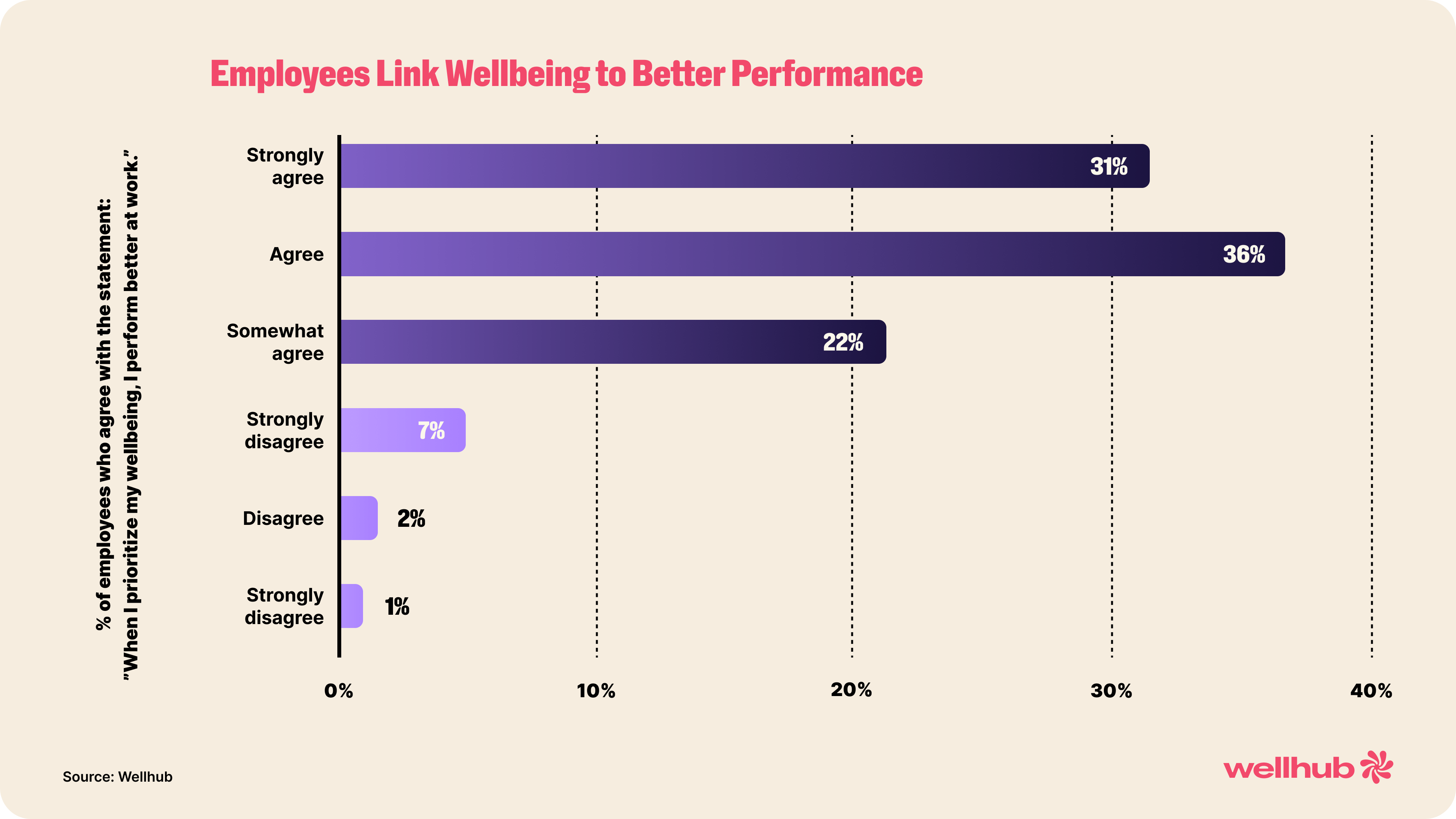
89% agree that when they prioritize their wellbeing, they are able to perform better at work.
The 2026 State of Work-Life Wellness Report, surveying over 5,000 employees across 10 countries, reveals that organizations investing in employee wellness programs see dramatic competitive advantages.
Corporate Wellness Programs Show Dramatic ROI
Across the workforce, 90% of employees say they experienced burnout symptoms in the past year, with nearly 40% experiencing them at least weekly. However, companies with structured employee wellness programs dramatically outperform those without:
- 61% of employees with wellness programs report that their overall wellbeing is good or thriving vs. 40% without
- 60% reportthat their physical health is good or thrivingvs. 43% without
- 79% feel their work allows time for wellbeing vs. 55% without
- 77% believe their HR department genuinely cares vs. 38% without
- 90% believe they are adequately compensated vs. 57% without
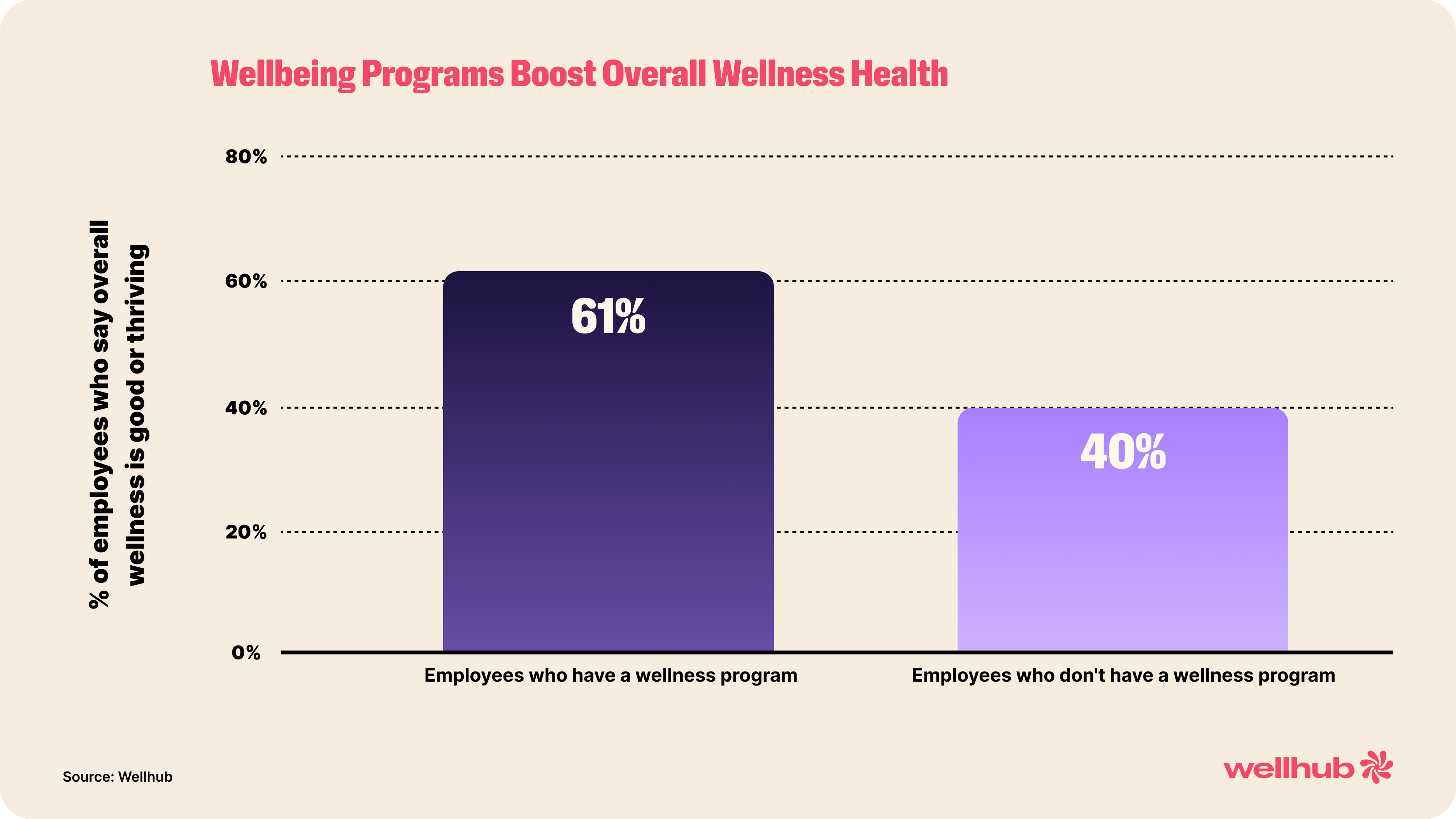
Employees with wellness programs: 61% report good/thriving wellbeing vs. 40% without programs
Wellness Spaces Replace the Water Cooler
The study identifies wellness-focused “third places”—spaces outside home and office where people gather for connection and care—as the new epicenter of workplace relationships. Employees are gravitating away from bars and coffee shops and toward gyms, yoga studios, and wellness hubs that serve as destinations for recharging, managing stress, and building community.
Ninety-one percent say these spaces help them handle work pressures more effectively, and 74% visit them weekly, with one in five going daily. Far from perks, they are becoming essential infrastructure for belonging and accountability, with 22% now connecting with coworkers in wellness spaces. Yet barriers remain—half of employees cite lack of time, while others point to motivation (27%) and cost (23%)—raising expectations for employers to provide greater wellness support.
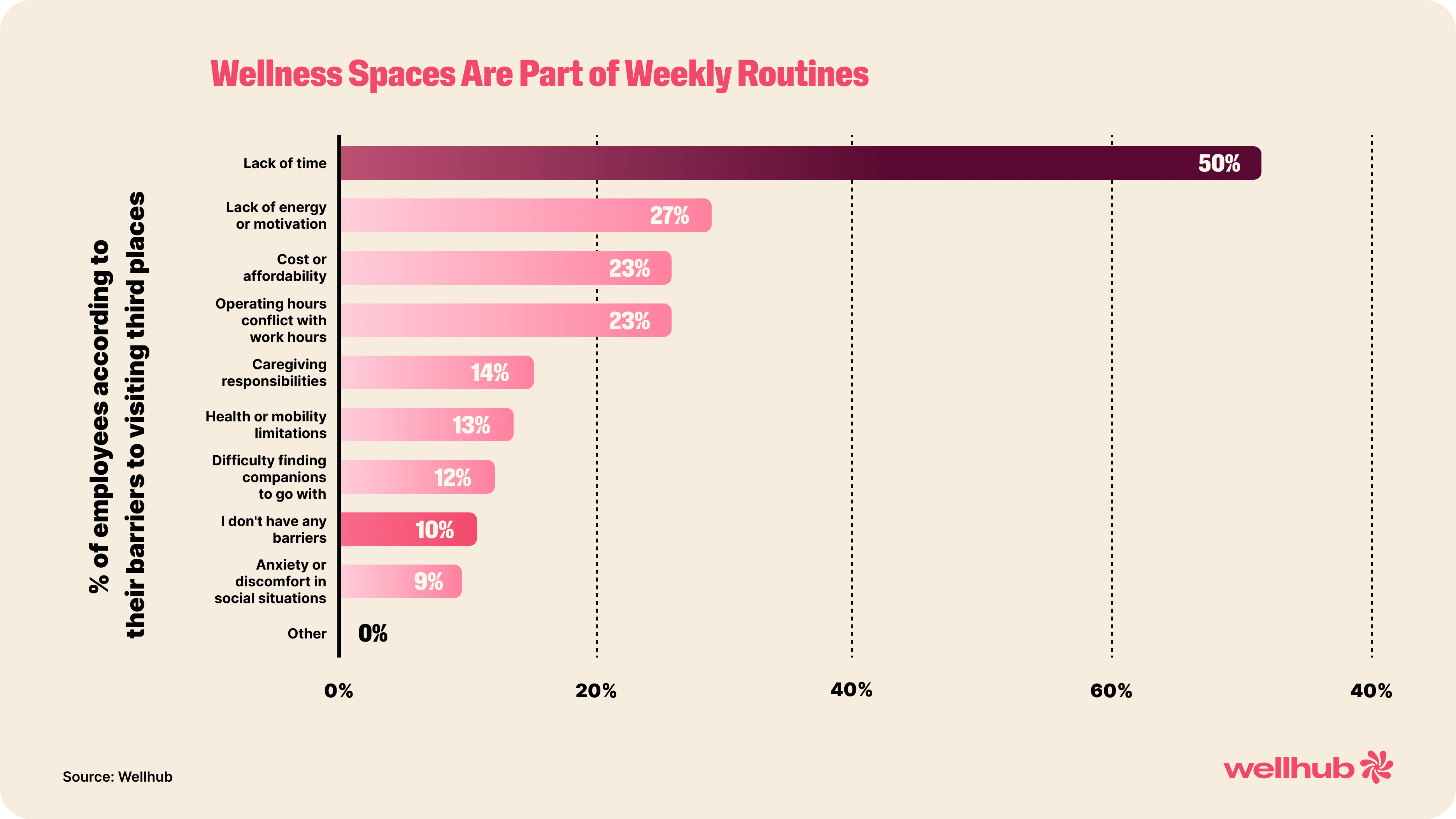
74% visit wellness spaces at least once per week, 21% go daily
Gen Z Leads Wellness Adoption as Response to Workplace Stress
Younger employees, often at the earliest and most formative stages of their careers, are carrying the heaviest emotional and mental loads. Among Millennials, 56% report rising stress levels, while 55% of Gen Z workers say the same, both figures exceeding the global average for all generations. Beyond general stress, these younger groups are the most likely to report frequent burnout symptoms, with many experiencing them several times per week.
Gen Z in particular is redefining what it means to care for themselves at work. Not only are they the most active adopters of digital wellness tools—72% use wellness apps weekly—but they are also the most likely to see therapy as essential to their wellbeing. More than two-thirds of Gen Z employees (68%) say therapy is critical to their overall wellbeing, compared to 59% of Millennials, 45% of Gen X, and just 33% of Baby Boomers.
This shows a generational shift: younger workers are rejecting outdated notions of resilience as “toughing it out” and are instead embracing structured, proactive approaches to care. They’re building a new model of sustainable career success—where mental health support, flexible roles, and integrated wellbeing tools are non-negotiable parts of the workplace experience.
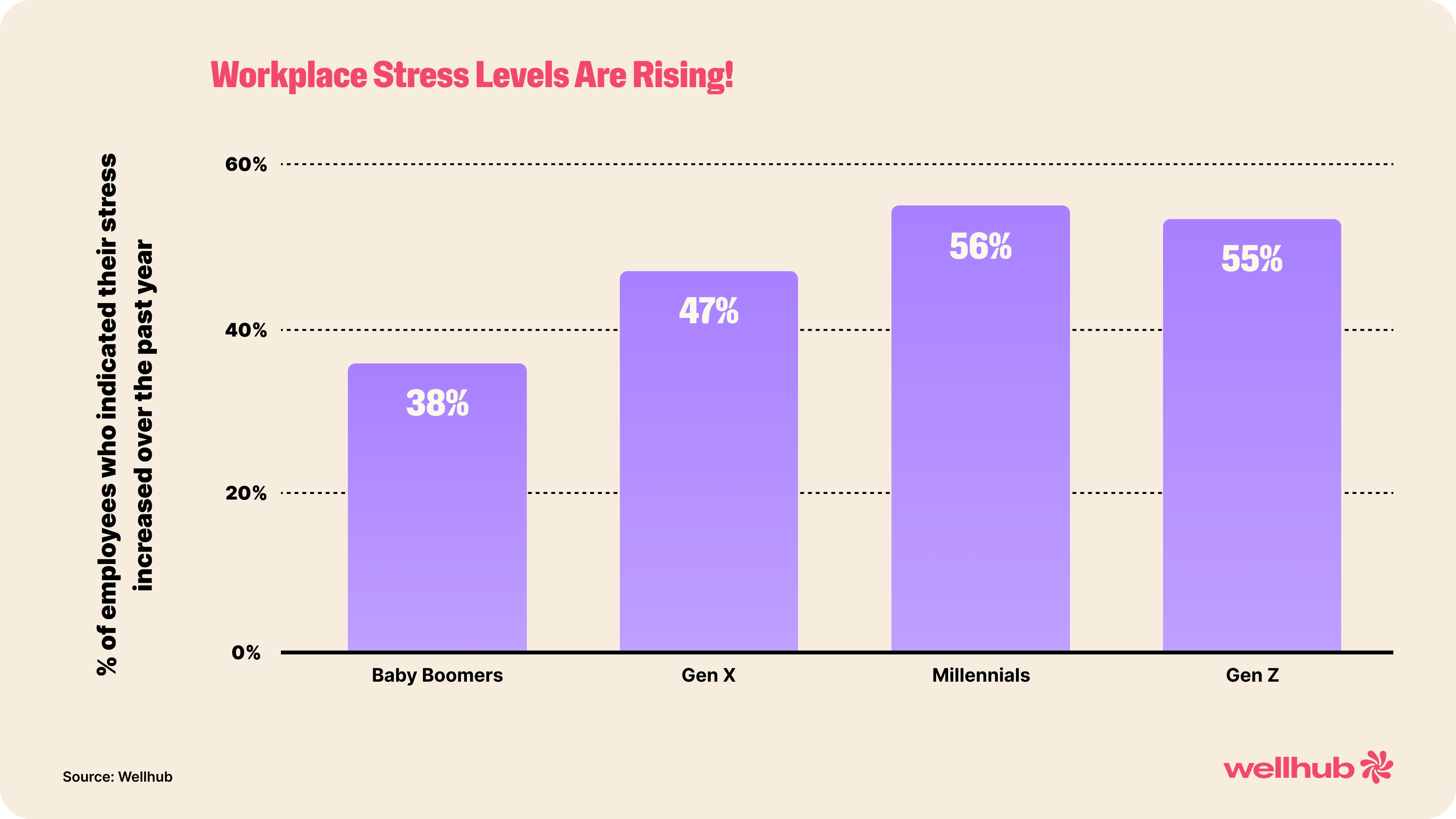
Baby Boomers 38%, Gen X 47%, Millennials 56%, Gen Z 55% report increased stress over the past year
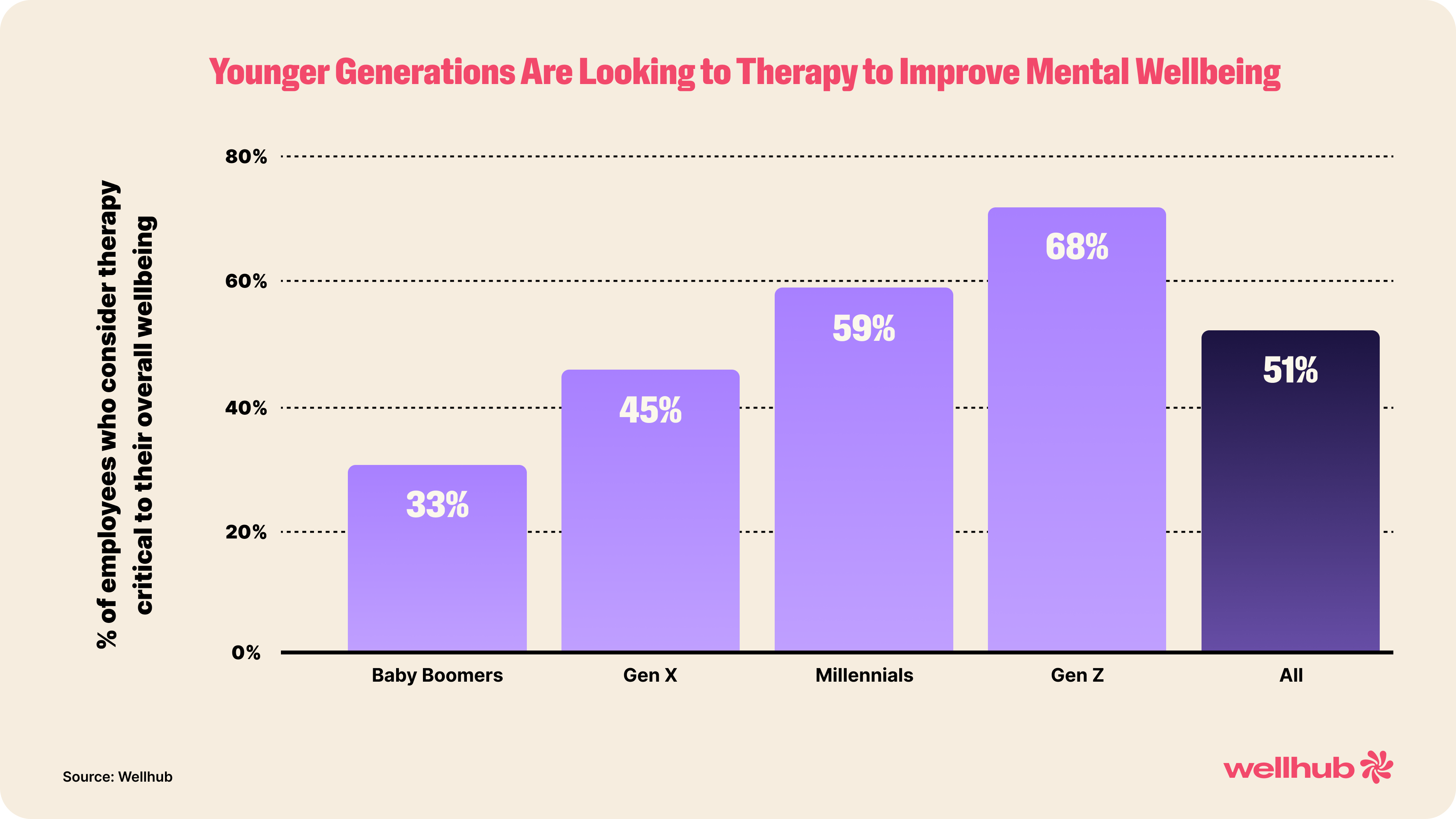
Gen Z is leading a cultural shift toward mental health support — 68% say therapy is essential to their wellbeing, compared with 59% of Millennials, 45% of Gen X, and just 33% of Baby Boomers.
The Competitive Advantage
Organizations using comprehensive wellness platforms see the strongest results. Forward-thinking companies are reshaping their benefits strategy around this reality, treating wellness not as a cost center but as their primary performance driver.
"We're seeing a fundamental shift from wellness as employee benefit to wellness as a productivity booster" said Cesar Carvalho, CEO and Co-Founder of Wellhub. "The most successful organizations are embedding wellness into their talent strategy because healthy employees don't just feel better—they perform better, stay longer, and drive business results."
The research suggests that wellness investment represents one of the highest-ROI talent strategies available, with benefits extending far beyond traditional health metrics to encompass engagement, retention, and measurable performance gains.
Methodology
Wellhub conducted its State of Work-Life Wellness 2026 survey to assess the current status of worker wellness and examine how well employee benefits packages are meeting worker needs.
Between May 13, 2025, and June 13, 2025, more than 5,000 full-time employees were surveyed online through the polling agency QuestionPro. The response pool included only workers 18 and older who have worked a full-time job in the last three months. The results have a 95% confidence level and a 5% margin of error.
Response options for the survey’s 94 questions (see “Survey Questions”) included Likert scales, multiple-choice, and multi-select options.
The countries included in this survey were: United States, United Kingdom, Brazil, Argentina, Chile, Spain, Italy, Germany, Mexico, and Romania. Between 500 and 505 responses were collected from each country. Where necessary, question sets and response options were adapted to reflect regional variations in benefit availability.
Category
Share

The Wellhub Newsroom shares the all of the latest company and wellbeing industry news. Discover what's happening. Are you a journalist? Contact us at press@wellhub.com.
Subscribe
Our weekly newsletter is your source of education and inspiration to help you create a corporate wellness program that actually matters.
Subscribe
Our weekly newsletter is your source of education and inspiration to help you create a corporate wellness program that actually matters.